This is an appendix to: Huser et al. 2023. Handbook – a decision-support tool for measures against internal phosphorus loading in lakes.
Download pdf-version of appendix 3
Purpose
The environmental monitoring described here aims to provide the data needed to quantify internal loading in a lake according to Step 2. The dataset can also be used when proceeding to Step 3, modelling.
Environmental monitoring
Environmental monitoring protocols differ for dimictic lakes and fully mixed lakes. Note that polymictic lakes (which may be periodically stratified) are sampled according to both protocols.
Stratified lakes – polymictic and dimictic
Profile data, primarily total phosphorus (TP) concentrations, are used to detect and quantify internal loading. Samples are taken at least once a month during the period from thawing (spring circulation) to autumn circulation. It is advisable to take a first sample before thawing if there is any suspicion that internal loading may be significant during the winter months. This is particularly true in northern Sweden. In southern and central Sweden, internal loading is usually much higher in the summer months than in winter due to higher water temperatures and a shorter period of ice cover.
A bathymetric map is needed to calculate the water volume in the lake at different depths (see Appendix 5).
Sampling protocol:
- Take samples only at the deepest point of the lake.
- Use sonar to measure and record the maximum depth before taking samples. It is important to do this in exactly the same place every time.
- Collect the bottom sample first[1] (1 m above the bottom).
- Measure and record oxygen and temperature at 0.5 m intervals from surface water (0.5 m) to 0.5 m above the bottom. Oxygen and temperature can be measured at 1 m intervals in lakes with maximum depth > 15 m. Start at 0.5 m and then measure at even depths (e.g. 1 m, 2 m, 3 m). If the lake is very deep, it is possible to measure at greater intervals at depths where the temperature and oxygen levels do not change much.
- Water sampling and sampling depth: At least five different depths should be sampled if the lake is less than 15 m deep; and six different depths if the lake is more than 15 m deep. The same sampling depth should be used for each sampling event. If the structure of the temperature profile during stratification is known from previous measurements, the following can be assumed: One sample is taken in surface water (0.5 m), one just above the metalimnion (usually about 4 m, but this may be deeper), one sample in or near the metalimnion (the thermocline), and two to three samples in the hypolimnion, one of which is a bottom sample taken 1 m above the bottom and one or two samples are taken between the bottom sample and the deepest sample in the metalimnion (see Figure 1). The following sampling depths can be used if no prior information on the temperature profile is available: 0.5 m, 4 m, 6 m, one or two evenly spaced sampling depths between 6 m and the maximum depth, and at the maximum depth – 1 m.
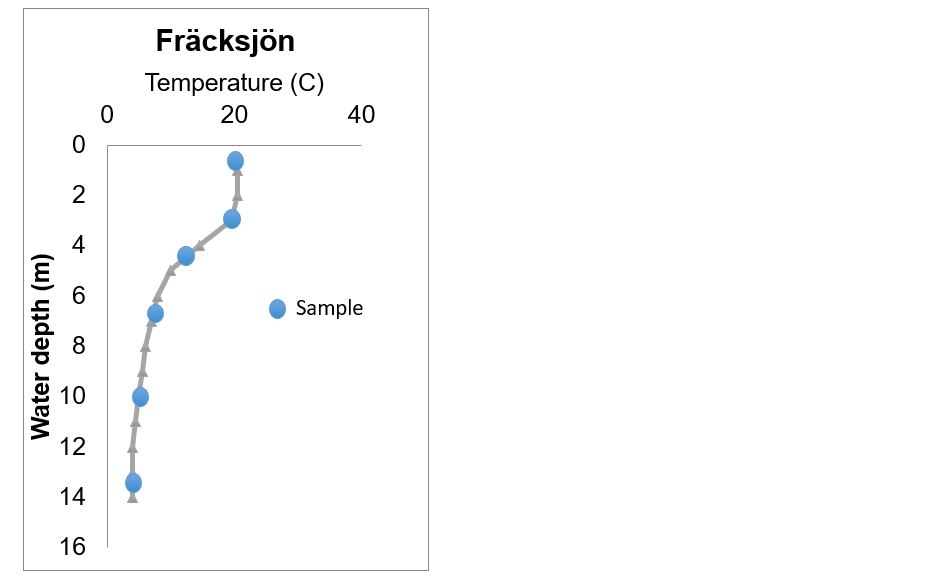
A number of different analytical parameters need to be used when calculating internal loading in stratified lakes:
- Obligatory:
- temperature and oxygen profile as above
- total phosphorus (TP)
- PO4-P
- Optional but important if modelling and/or status classification of other parameters is performed[2]:
- nitrogen (total nitrogen, ammonium nitrogen and nitrate + nitrite nitrogen) throughout the profiledissolved total phosphoruschlorophyll a (surface water only)water transparencyCalcium (surface water only)Magnesium (surface water only)Chloride (surface water only)Sulphate (surface water only)Turbidity (FNU) or suspended material (surface water only)absorbance 420 nm (surface water only)
- pH.
Polymictic and fully mixed lakes
The difference between the input and output of phosphorus from the lake and changes in the amount of phosphorus in the lake are used to calculate internal loading. Having a bathymetric map is needed to correctly calculate the water volume of the lake and to calculate the effect of changes in water level on the water volume. If there is no bathymetric map, the water volume can be estimated using the lake area and mean depth of the lake. The change in water volume can be estimated from the total area of the lake and the changes in water level.
The following measurements need to be carried out during the summer months:
- Sampling of inflowing and outgoing water at least once a month (in the event of high flows, or if the turnover time in the lake < 3 months, preferably once a fortnight) during the period after thawing until October.
- Sampling the surface water of the lake (0.5 m) at the centre of the lake[3], and measuring the water level in the lake.
- The amount of phosphorus flowing into and out of the lake. This amount is calculated by measuring TP concentrations in the inlets and outlets and estimating their volumetric water flow rates. The latter is done either by measuring the watercourse cross-section and the streamflow velocity using a flowmeter or in shallow streams using the floatation method with a buoyant object. If present, culverts are often best used for such measurements. If the water body is included in a comprehensive hydrological model such as in Sweden SMHI’s S-HYPE water model, these modelled data can be used. However, measurements should normally be made to verify whether the modelled data can be used directly, has to be calibrated using measured data, or whether it cannot be used because of major uncertainties.
The following analytical parameters should be used when sampling inflows and outflows:
- Obligatory:
- Volumetric waterflow rate, Q, in inlets and outlets (m3/s)
- total phosphorus.
- Optional, but important if modelling (Step 3) is to be performed2:
- PO4-P
- dissolved total phosphorus
- nitrogen (total nitrogen, ammonium nitrogen and nitrate + nitrite nitrogen)
- turbidity or suspended material
- chlorophyll a.
It is important to have reliable data for phosphorus concentration and water volume in order to calculate how the amount of phosphorus in the lake changes during the summer. The phosphorus concentration at the outlet can be used, but this is not always representative of that present in the lake. There are processes that can increase sedimentation of particles and reduce phosphorus concentrations in water as it leaves the lake. Water samples should therefore preferably be taken in the lake when possible. The sampling frequency in the lake should be at least once a month, or preferably more often in high summer when internal loading is often greatest.
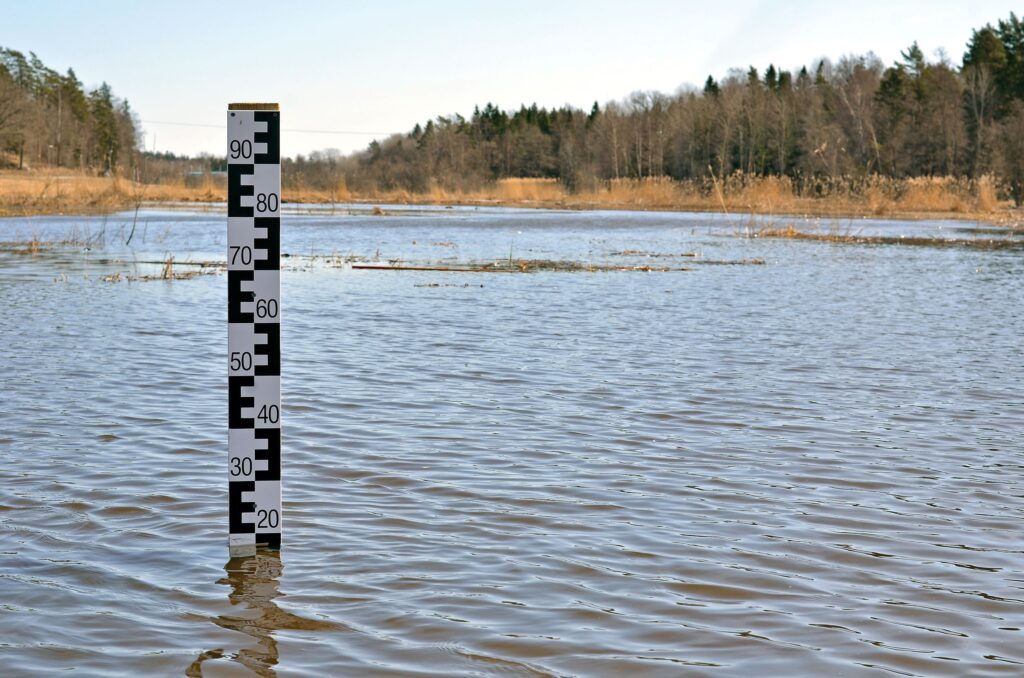
The water level in the lake can change significantly in summer, which affects the water volume and the calculated amount of phosphorus. Therefore, if possible, attempts should be made to measure the water level of the lake every time samples are taken. A simple way is to measure the water level is by using a ruler at a fixed structure in or above the water (e.g. a jetty), which gives a measure of the relative change in the water level of the lake. The bathymetry of the lake is then used to calculate water volumes at different water levels.
There are a number of analytical parameters in addition to inlet and outlet sampling that need to be taken into consideration when taking samples in the lake.
- Mandatory:
- water level
- total phosphorus
- temperature
- oxygen.
- Optional, but important if modelling (Step 3) is to be performed2:
- PO4-P
- dissolved total phosphorus
- water colour
- water transparency
- nitrogen (total nitrogen, ammonium nitrogen and nitrate + nitrite nitrogen)
- turbidity or suspended material
- chlorophyll a.
The method requires suitable conditions for measuring the lake’s major inputs and outputs of phosphorus. One should aim for to be able to measure at least 80% of the inflows.
It is also possible to use data from data from a hydrological model before starting environmental monitoring in order to get an estimate of the size of external phosphorus inputs in relation to any expected internal load. If the external load is of the same order of magnitude or greater than the expected internal load, or if the lake has a short turnover time during the summer months, it becomes particularly important for Pin and Pout to be measured as accurately as possible.
A total water balance for the lake can be established if the total external phosphorus input is high and it is suspected that important sources may not be included. Besides inflows and outflow, such a water mass balance should consider precipitation on the surface of the lake, evaporation from the lake and changes in the lake’s water volume. Discrepancies in the balance may indicate that there are sources of inflow or outflow that have been missed. However, unexplained inflow does not always mean that there is also an unexplained input of phosphorus. This may, for example, be the case if the unexplained inflow is from groundwater, which normally has very low phosphorus concentrations. Remember that groundwater may be both a source and a sink.
If the conditions for measuring the phosphorus influx are poor, internal loading can be approximated from the increase in the amount of phosphorus in the lake during the summer months. In this case, it is sufficient to carry out measurements of the surface water of the lake, or failing that at the outflow. This method, however, involves a great deal of uncertainty; and it needs to be established with the help of data from hydrological models, meteorological data, or at its simplest from the size of the catchment area relative to that of the lake, that inflows can be assumed to be small during the period of study.
Sampling and analysis
Selection of samplers and analysing laboratories
The results should be independent of both the sampler and the analysing laboratory. It is therefore important that the analysing laboratory is accredited for the methods used. If sampling is carried out by different people it is important that there is full agreement on sampling procedures and locations. GIS coordinates must be used to find the same location for measuring maximum depth and sampling every time samples are taken.
Sampling procedures and analysis methods
In Sweden, the following analytical methods for water chemistry set out in HVMFS 2019:25[4] should be used. The analytical methods are as follows for the obligatory parameters:
- Total phosphorus is measured according to SS-EN ISO 6878, SS-EN ISO 15681, or using another method that gives equivalent results.
- Phosphate phosphorus is measured filtered or unfiltered according to previous methodology so that data are comparable over time – unfiltered is the standard for freshwater. Analysis is performed according to SS-EN ISO 6878 or SS-EN ISO 10304-1, SS-EN ISO 15681, or using another method that gives equivalent results.
- Dissolved total phosphorus[5] is measured according to SS-EN ISO 6878:2005. The method description is only available in English, and the “Total dissolved phosphorus” method is to be used. This is described under the heading “Determination of total phosphorus after peroxodisulfate oxidation”. Analysis is performed on a filtered sample.
- Chlorophyll a must have been measured and analysed according to SS-EN ISO 5667-1:2007 and SS 28146 or using another method that gives equivalent results.
- Absorbance (420 nm) is measured on a filtered sample according to EN ISO 7887:2012, 5 cm cuvette.
Summary of results
Calculation of internal loading
Any internal loading in dimictic lakes is detected and quantified from profile data for temperature, oxygen and TP and the bathymetry of the lake. Examples of the evolution of the phosphorus profile during the summer are shown in Figure 2. For mixed and polymictic lakes (and in some cases as a complement for dimictic lakes), internal loading is quantified from a (monthly) phosphorus balance of the lake, or simply from the changes in the TP content and water volume of the lake during the summer. Data from reference lakes with little or no anthropogenic impact are used to take into account natural background internal loading and calculate the amount of elevated internal loading. A working method describing how to calculate internal loading is provided in Appendix 4.
Sampling and analysis of sediments to determine the amount of mobile phosphorus
Water sampling may be complemented with sediment sampling and analysis in order to determine the amount of mobile phosphorus. Unlike water sampling, sediment analysis provides information on the potential (maximum) phosphorus release from the sediments. This analysis is mainly relevant when the results of water sampling show that internal loading is high or very high and that action is likely to be needed to reduce it. Information on the amount of mobile phosphorus in the sediment is particularly important for dynamic lake modelling and the correctly dimension measures that are based on chemical binding of mobile phosphorus in the sediments or on the removal of sediments by dredging (see the part II of the Handbook for a description of the measures).
Sampling
Sediment cores must be sampled during the part of the year when internal loading is at its lowest and the amount of mobile phosphorus in the sediments at its peak. In lakes not covered with ice, sampling is therefore best carried out during the coldest period in late autumn, from a couple of weeks after autumn mixing until spring, before the lake stratifies. In lakes covered with ice, sampling can be carried out a few weeks after the ice thaws or in the fall 2-3 weeks after stratification breaks down and the lake water mixes, or the coldest period before ice forms in well mixed lakes.
Sampling at multiple locations is needed in order to quantify the amount of mobile phosphorus spatially across the whole lake. It is not possible to specify exactly how many sample sites are needed as this is dependent on a number of lake-specific factors such as the size of the lake, its geomorphology and the location of the sources of external loading. A general rule of thumb is that the number of samples increases according to the size of the lake, as shown in Table 1. However, it is always necessary to adjust the number of samples according to the site-specific conditions in and around the lake.
| Lake size (ha) | Number of samples |
| < 25 ha | 3 |
| 25–250 | 1 per 25 ha, at least 3 |
| 250–1000 | 1 per 50 ha |
| > 1000 | Must be assessed |
The greatest amount of mobile phosphorus is often found in the top 10 to 15 cm of the sediment, but it can also be found further down if the influence of benthic fish – for example – increases the mixing depth of the sediment. However, it is necessary to sample deeper sediment in order to detect background concentrations for the mobile forms of phosphorus in the sediment. The results of sediment analyses can be used to assess the depth to which significant amounts of mobile phosphorus are present and is known as the active sediment depth.
The sediment cores should be divided into several layers and analysed individually, e.g. as indicated below:
- 0–2 cm
- 2–4 cm
- 4–6 cm
- 6–10 cm
- 10–15 cm
- 15–20 cm
- 25–30 cm
It is important for the division of layers is continuous in the upper sediment, as amounts of mobile phosphorus can vary greatly with depth as a result of variations in current and historical sources of phosphorus inputs that have affected the lake. If a mixing sediment depth greater than 30 cm is expected, it is possible to add more, deeper samples, e.g. 30–35 cm, and so on.
What is known as an excess of mobile phosphorus in the active sediment depth is calculated by comparing the levels in the active depth with the background levels deeper in the sediment. That is why it is important for the sampling depth to be greater than the expected active sediment depth.
Analyses
Phosphorus fractionation is used to estimate the amount of different forms of phosphorus in the sediment. According to the method applied by Psenner et al. (1988)[6], the various fractions are categorised as follows:
- Loosely bound and pore-water phosphorus is extracted using an NH4Cl solution or ultrapure water.
- Iron-bound (reductant soluble) phosphorus is extracted using a buffered sodium dithionite solution.
- Aluminium-bound (ligand exchangeable) phosphorus is extracted using a NaOH solution.
- Organic phosphorus is extracted using a NaOH solution under high temperature and pressure.
- Calcium-bound phosphorus is extracted using an HCl solution.
- Residual phosphorus is calculated as the difference between total phosphorus and the sum of all extracted phosphorus fractions.
Under neutral pH conditions, mobile phosphorus is the sum of loosely bound and iron-bound phosphorus, as well as the portions of the organic and residual phosphorus fractions that are considered labile or releasable.
The analyses required are phosphorus fractionation, total phosphorus, dry weight and loss on ignition. Dry weight and loss on ignition data are used to convert concentrations to the mass of phosphorus in the sediment. The phosphorus mass is what drives internal loading, and the phosphorus mass is also used to develop measures to reduce internal loading.
Figure 2. Example of the development of phosphorus profiles during the summer in two stratified lakes, Drevviken and Ulvsundasjön. The green area is used to quantify internal loading.
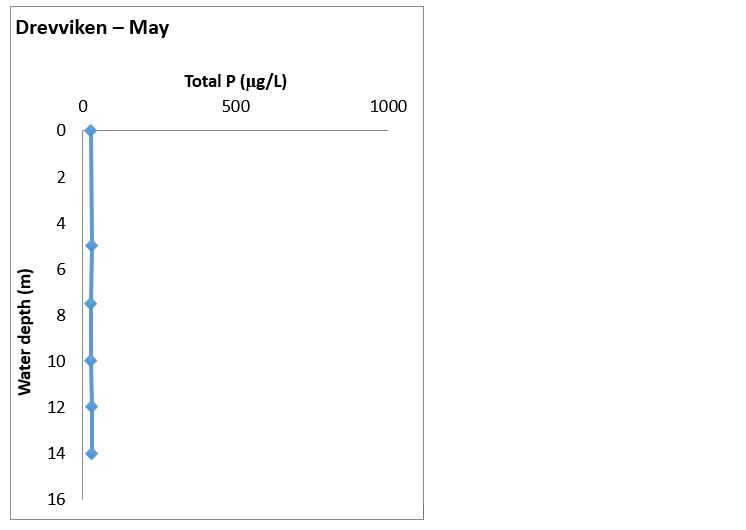
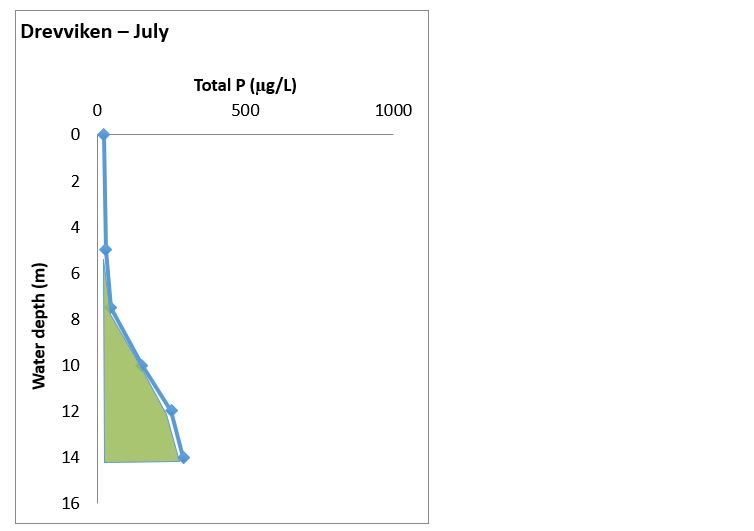
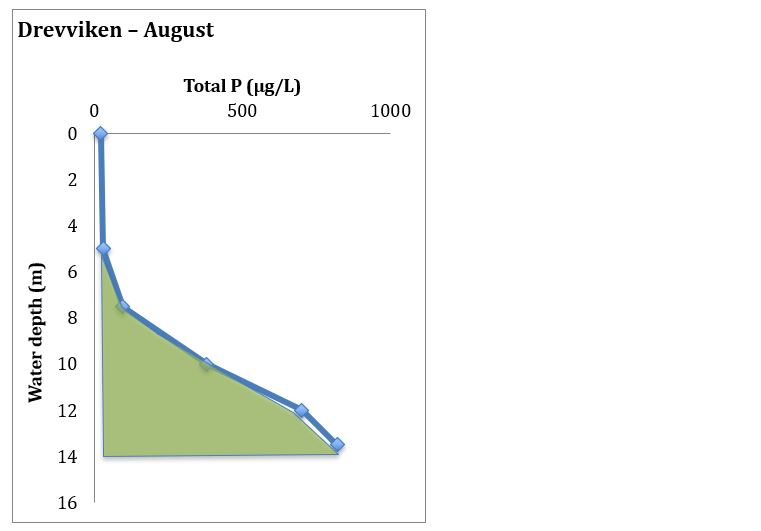
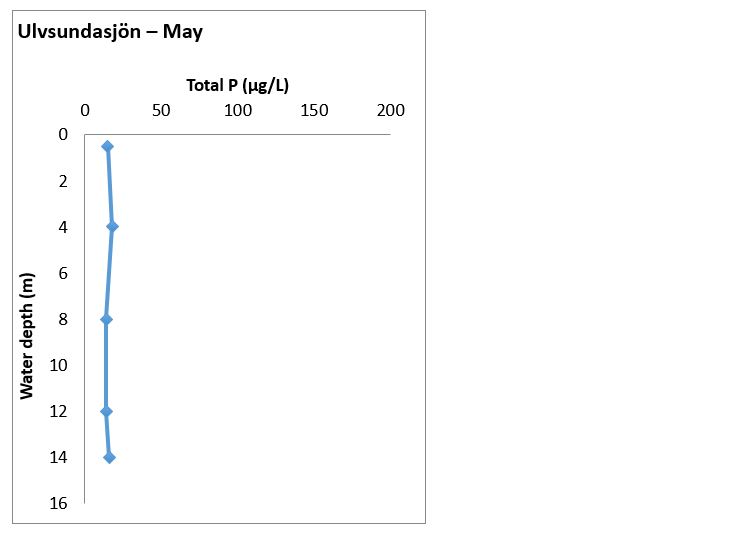
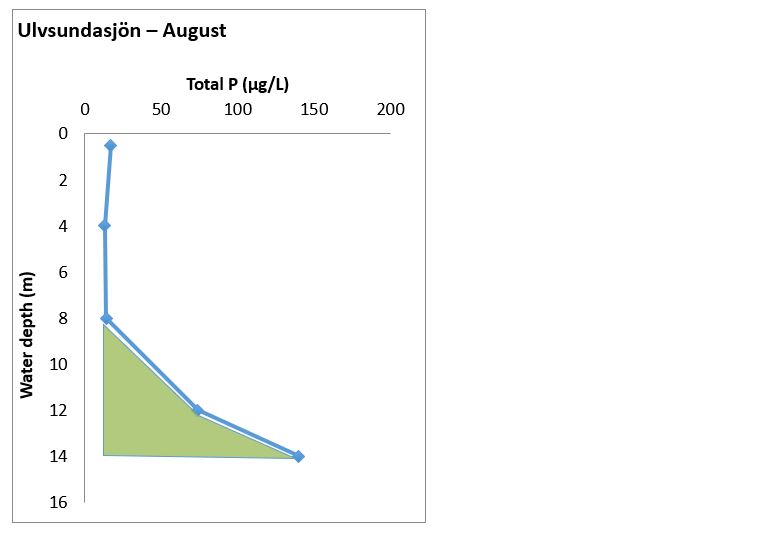
Footnotes
[1] The aim of this is to reduce the risk of sediment mixing with the bottom water sample if the oxygen and temperature probe accidentally ends up in the sediment.
[2] Optional analytical parameters are those that could potentially be useful in the assessment, dynamic modelling in Step 3 of the tool, or that may be used as a basis for status classification of the water.
[3] Most important is to avoid shallow areas with large amounts of macrophytes such as reeds, as macrophytes can stabilise the water column and increase sedimentation rates. Phosphorus levels may be significantly lower in such areas compared to other areas where the water can be mixed.
[4] Swedish Agency for Marine and Water Management regulations (HVMFS 2019:25) on classification and environmental quality standards for surface water.
[5] Note that this is an optional parameter for shallow lakes only.
[6] Psenner R, Boström B, Dinka M, Pettersson K, Puckso R and Sager M. 1988. Fractionation of phosphorus in suspended matter and sediment. Archiv Für Hydrobiologie Supplement. 30:98–103.


